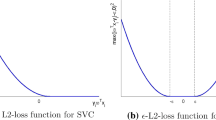Abstract
Although the solution of support vector machine (SVM) is relatively sparse, it makes unnecessarily liberal use of basis functions since the number of support vectors required typically grows linearly with the size of the training set. In this paper, we present a simple post-processing method to sparsify the solution of support vector regression (SVR). The main idea is as follows: first, we train a SVR machine on the full training set; then another SVR machine is trained only on a subset of the full training set with modified target values. This process is done several times iteratively. Experiments indicate that the proposed method can reduce the support vectors greatly while maintaining the good generalization capacity of SVR.


Similar content being viewed by others
Explore related subjects
Discover the latest articles and news from researchers in related subjects, suggested using machine learning.References
Drucker H, Burges CJC, Kaufman L, Smola AJ, Vapnik V (1997) Support vector regression machines. In: Mozer M, Jordan M, Petsche T (eds) Advances in Neural Information Processing System. MIT press, Cambridge
Schölkopf B, Smola AJ (2002) Learning with kernels. MIT Press, Cambridge
Girosi F (1998) An equivalence between sparse approximation and support vector machines. Neural Comput 10(6):1455-1480
Tipping ME(2001) Sparse Bayesian learning and the relevance vector machine. J Mach Learn Res 1:211–244
Figueiredo MAT (2003) Adaptive sparseness for supervised learning. IEEE Trans Pattern Anal Mach Intell 25(9):1150–1159
Roth V (2004) The generalized LASSO. IEEE Trans Neural Netw 15(1):16–28
MacKay D (1994) Bayesian nonlinear modeling for the prediction competition. In: ASHRAE Trans, vol 100, Atlanta, GA, pp 1053–1062
Burges CJC (1996) Simplified support vector decision rules. In: Saitta L (ed) Proceeding of the thirteenth international conference on machine learning. Morgan Kaufmann, Bari, pp 71–77
Burges CJC, Schölkopf B (1997) Improving the accuracy and speed of support vector machine. In: Mozer M, Jordan M, Petsche T (eds) Advances in Neural Information Processing System 9. MIT press, Cambridge, MA, pp 375–381
Platt JC (1998) Fast training of support vector machines using sequential optimization. In: Schölkopf B, Burges CJC, Smola AJ (eds) Advanced in kernel methods: support vector machines. MIT press, Cambridge, pp185–208
Shevade SK, Keerthi SS, Bhattacharyya C, Murthy KRK (2000) Improvements to SMO algorithm for SVM regression. IEEE Trans Neural Network, 11(5):1188–1193
Wu MR, Schölkopf B, Bakir G (2006) A direct method for building sparse kernel learning algorithms. J Mach Learn Res 7:455-491
Dekel O, Singer Y (2006) Support vector machines on a budget. In: Schölkopf B, Platt J, Hofmann T (eds) Advances in Neural Information Processing Systems 19. MIT press, Cambridge, pp 345–352
Chang CC, Lin CJ (2001) LIBSVM: a library for support vector machines. Software available at http://www.csie.ntu.edu.tw/cjlin/libsvm
Collobert R, Bengio S(2001) SVMTorch: support vector machines for large-scale regression problems. J Mach Learn Res 1:143–160
Osuna E, Girosi F(1999) Reduing the run-time complexity of support vector machines. In: Schölkopf B, Smola AJ (eds) Advances in kernel methods: support vector learning, MIT press, Cambridge, pp 271–284
Schölkopf B, Smola AJ, Williamson RC, Bartlett PL (2000) New support vector algorithms. Neural Comput 12:1207–1245
Chang CC, Lin CJ(2002) Training ν-support vector regression: theory and algorithms. Neural Comput 13(9):2119–2147
Chen PH, Lin CJ, Schlökopf B (2005) A tutorial on ν-support vector machines. Appl Stoch Model Bus Ind 21:111–136
Mattera D, Palmieri F, Haykin S (1999) Simple and robust methods for support vector expansions. IEEE Trans Neural Network 10(5):1038-1047
Eubank RL (1999) Nonparametric regression and spline smoothing. In: Statistics: textbooks and monographs, 2nd edn, vol 157. Marcel Dekker, New York
Michie D, Spiegelhalter DJ, Taylor CC (1994) Machine learning, neural and statistical classification. Prentice-Hall, Englewood Cliffs. Data available at ftp://ncc.up.pt/pub/statlog/
Li HQ, Wan BW (2003) Multi-input-layer wavelet neural network and its application. In: Proceedings of the fifth international conference on computational intelligence and multimedia application (ICCIMA’03), pp 468–473
Acknowledgments
This research was supported by Natural Science Foundation of China (60373106, 40225004).
Author information
Authors and Affiliations
Corresponding author
Rights and permissions
About this article
Cite this article
Guo, G., Zhang, JS. & Zhang, GY. A method to sparsify the solution of support vector regression. Neural Comput & Applic 18, 919–926 (2009). https://doi.org/10.1007/s00521-009-0255-1
Received:
Accepted:
Published:
Issue Date:
DOI: https://doi.org/10.1007/s00521-009-0255-1




